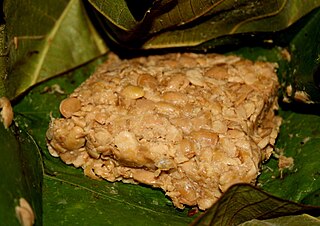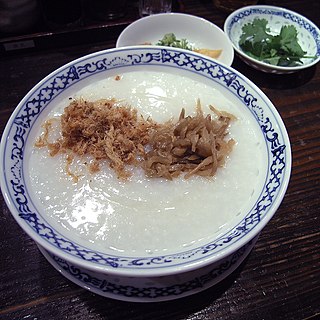Related Research Articles

A dosa, dose, dosai, or dosha is a thin, savoury crepe in Indian cuisine made from a fermented batter of ground black gram and rice. Dosas are served hot, often with chutney and sambar. Dosas are a common food in South India.

Idli or idly or iddali or iddena is a type of savoury rice cake, originating from South India, popular as a breakfast food in Southern India and in Sri Lanka. The cakes are made by steaming a batter consisting of fermented de-husked black lentils and rice. The fermentation process breaks down the starches so that they are more readily metabolised by the body.

Biryani is a mixed rice dish popular in South Asia, made with rice, meat, prawn or fish and spices. To cater to vegetarians, vegetables or paneer can be substituted for the meat. Sometimes eggs or potatoes are also added.

Assamese cuisine is the cuisine of the Indian state of Assam. It is a style of cooking that is a confluence of cooking habits of the hills that favour fermentation and drying as forms of preservation and those from the plains that provide extremely wide variety of fresh vegetables and greens, and an abundance of fish and meat. Both are centred on the main ingredient — rice. It is a mixture of different indigenous styles with considerable regional variations and some external influences. The traditional way of cooking and the cuisine of Assam is very similar to South-East Asian countries such as Thailand, Burma (Myanmar) and others. The cuisine is characterized by very little use of spices, little cooking over fire, and strong flavours due mainly to the use of endemic exotic fruits and vegetables that are either fresh, dried or fermented. Fish is widely used, and birds like duck, pigeon, squab, etc. are very popular, which are often paired with a main vegetable or ingredient; beef used to be eaten before British colonialism, and some continue to do so. Preparations are rarely elaborate. The practice of bhuna, the gentle frying of spices before the addition of the main ingredients so common in Indian cooking, is absent in the cuisine of Assam. The preferred oil for cooking is the pungent mustard oil.

Curd rice, also called yogurt rice, is a dish originating from India. The word "curd" in Indian English refers to unsweetened plain yogurt. It is most popular in the South Indian states of Tamil Nadu, Kerala, Karnataka, Telangana and Andhra Pradesh; and also in West Indian states of Rajasthan, Gujarat and Maharashtra.
Maharashtrian or Marathicuisine is the cuisine of the Marathi people from the Indian state of Maharashtra. It has distinctive attributes, while sharing much with other Indian cuisines. Traditionally, Maharashtrians have considered their food to be more austere than others.

Indian breads are a wide variety of flatbreads and crêpes which are an integral part of Indian cuisine. Their variation reflects the diversity of Indian culture and food habits.

Panta Bhat or Poita Bhat consists of cooked rice soaked and fermented in water. The liquid part is known as Toraṇi. It is a rice-based dish prepared by soaking rice, generally leftover, in water overnight. Traditionally served in the morning with salt, onion, chili and Aloo Makha/Alu Pitika. It is consumed in eastern Indian states of West Bengal, Odisha (Pakhala), Jharkhand, Chhattisgarh, Assam, Tripura and in the country of Bangladesh. Panta Bhat with Ilish (Hilsha) is the National Dish of Bangladesh. It is a popular dish on the day of Pahela Baishakh or Bengali new year. It has been described in documents from 17th century. Panta bhat has more micronutrients than fresh rice. It is traditionally considered as beneficial in conditions.

Pakhaḷa is an Odia cuisine, consisting of cooked rice washed or lightly fermented in water. The liquid part of the dish is known as Toraṇi. It is popular in the state of Odisha and its similar in the eastern regions like Jharkhand the northeastern states of Assam.
Bhojpuri cuisine is a style of food preparation common among the Bhojpuri people of Bihar, Jharkhand and eastern Uttar Pradesh in India, and also the Terai region of Nepal. Bhojpuri foods are mostly mild and tend to be less hot in terms of spices used. The cuisine consists of both vegetable and meat dishes.

A staple of Bhutanese cuisine is Bhutanese red rice, which is like brown rice in texture, but has a nutty taste. It is the only variety of rice that grows at high altitudes. Other staples include buckwheat and increasingly maize.

A sanna is a spongy, steamed, and savoury unfilled dumpling originally made of red rice, black lentil and coconut in the Konkan region, by the western coast of the Indian subcontinent. They originated in Goa and Damaon, Mangalore, Bombay and Bassein (Vasai), and are especially popular among Goans, both the Goan Hindus and Goan Christians, and also among the Konkani migrants outside Konkan in Karachi, Sindh, Gujarat, Karnataka and Kerala. They are also loved by the people of the Konkan division, such as the Kupari of the Bombay East Indian community.

Kinema is a fermented soybean food, prepared by the Kirati communities of the Eastern Himalayas region: Eastern Nepal, and Darjeeling, Kalimpong and Sikkim regions of India. Kinema also known as Kinama, which is a traditional food of the Kirati people.

A mango pickle is a variety of pickle prepared using mango. It is very popular in South and Southeast Asia. These sour/spicy pickles are also available commercially.

Malaysian Indian cuisine, or the cooking of the ethnic Indian communities in Malaysia, consists of adaptations of authentic dishes from India, as well as original creations inspired by the diverse food culture of Malaysia. Because the vast majority of Malaysia's Indian community are of South Indian descent, and are mostly ethnic Tamils who are descendants of immigrants from a historical region which consists of the modern Indian state of Tamil Nadu and Sri Lanka's Northern Province, much of Malaysian Indian cuisine is predominantly South Indian-inspired in character and taste. A typical Malaysian Indian dish is likely to be seasoned with curry leaves and whole and powdered spice, and to contain fresh coconut in various forms. Ghee is still widely used for cooking, although vegetable oils and refined palm oils are now commonplace in home kitchens. Before a meal it is customary to wash hands as cutlery is often not used while eating, with the exception of a serving spoon for each respective dish.

Naem is a pork sausage in Lao and Thai cuisine. It is a fermented food that has a sour flavor. It has a short shelf life, and is often eaten in raw form after the fermentation process has occurred. It is a popular Southeast Asian food, and different regions of Southeast Asia have various preferred flavors, including variations of sour and spicy. Naem is used as an ingredient in various dishes and is also served as a side dish.

Congee is a form of savoury rice porridge made by boiling rice in a large amount of water until the rice softens. Depending on rice-water ratio, the thickness of congee varies from a Western oatmeal porridge to a gruel. Since the history of rice cultivation in Asia stretches back to the Baiyue-inhabited lower Yangtze circa 10000 BC, congee is unlikely to have appeared before that date. Congee is typically served with side dishes, or it can be topped with meat, fish and pickled vegetables.

In Indian cuisine, dhal, parippu, pappu, or paruppu are dried, split pulses that do not require soaking before cooking. India is the largest producer of pulses in the world. The term is also used for various soups prepared from these pulses. These pulses are among the most important staple foods in South Asian countries, and form an important part of the cuisines of the Indian subcontinent.

Dahi or curd, also mosaru, dahi, thayir and perugu, is a traditional yogurt or fermented milk product originating from and popular throughout the Indian subcontinent. It is usually prepared from cows' milk, and sometimes buffalo milk or goat milk. The word curd is used in Indian English to refer to homemade yogurt, while the term yogurt refers to the pasteurized commercial variety known as "heat-treated fermented milk".
References
- ↑ Dr. K. M. Nadkarni's Indian Materia medica, Volume 2. Popular Prakashan, 1994 - Medicine, Ayurvedic - 968 pages. ISBN 8171541437, ISBN 9788171541430